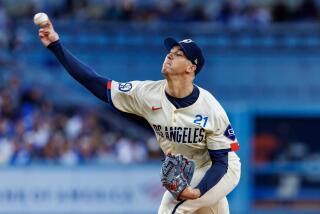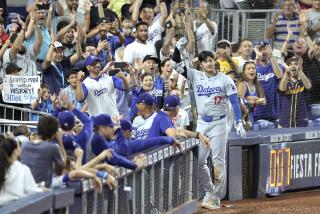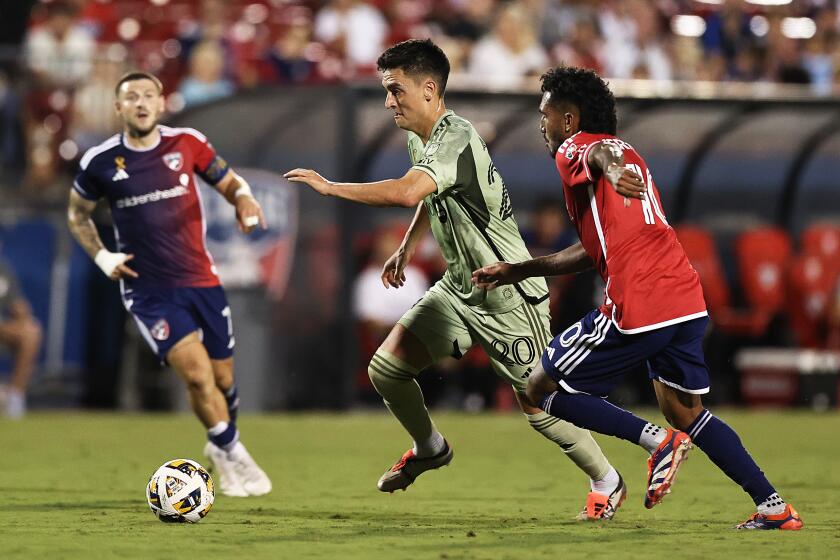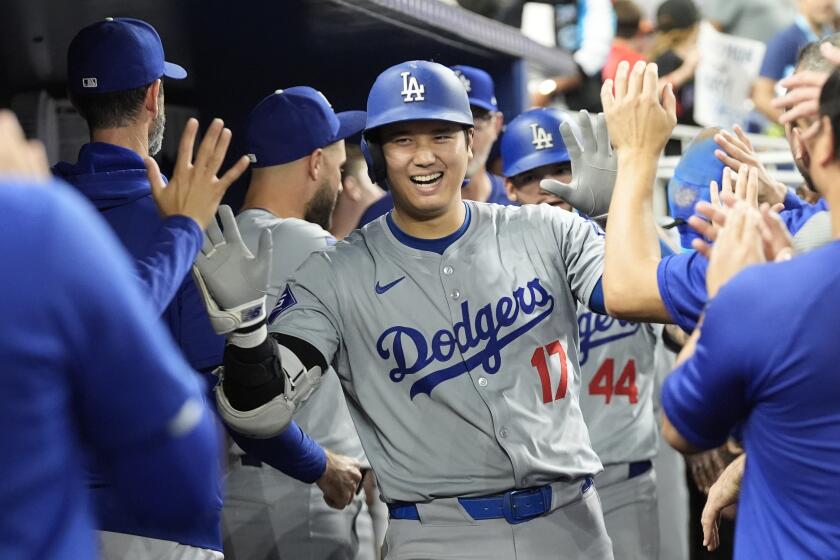When they were riding high
Outlined against the “rock-ribbed ledges” of the Arroyo Seco and “the broad sweep of a mild sun,” the Four Horsemen rode one last time in the Rose Bowl of Jan. 1, 1925.
Notre Dame arrived Dec. 31, only one day in advance of its 27-10 victory over Stanford.
The game punctuated a 10-0 season, a first consensus national title, coaching immortality for Knute Rockne and Notre Dame’s embryonic status as America’s Team.
It was a newspaper -30- for the aliases of sportswriter Grantland Rice’s apocalyptic deadline dash: Famine, Pestilence, Destruction and Death, known in street clothes as Harry Stuhldreher, Don Miller, Jim Crowley and Elmer Layden.
Depicted as beasts in print, the players averaged 158 pounds with not one measuring taller than 6 feet.
Notre Dame elected not to play in another bowl until 1970.
The Irish would not appear in the Rose Bowl again until . . . Saturday night.
The opponent this time will be Karl Dorrell’s UCLA Bruins, in a regular-season game, not Glenn “Pop” Warner’s Stanford Indians in the bowl game of a century to that point.
The Rose Bowl then was Notre Dame putting finishing touches on a historic season.
The Rose Bowl now is the Irish trying to salvage a forgettable one.
Notre Dame and the Rose Bowl have quietly maintained a love affair that has endured eight decades.
A couple of years ago, Rose Bowl Chief Executive Mitch Dorger visited Notre Dame in an attempt to corroborate an oft-told story that proceeds from the 1925 game -- $52,000 by one reported account -- helped build dormitories used by students today.
Dorger literally staked out position in front of Dillon Hall.
“I stopped the first kid coming out of the dorm,” Dorger recalled. “I just stuck out my hand and said, ‘Hi, I’m Mitch Dorger of the Rose Bowl. I understand this dorm was built with money from the Rose Bowl.’ ”
Dorger said the student, without hesitation, confirmed that Dillon was known as “Rose Bowl Dorm,” and that incoming students are “taught that as part of the lore of the dormitory.”
Dorger almost didn’t need a plane to fly home.
No one yet has been able to nail down the particulars. Some historical accounts had the money earmarked for a new gymnasium.
This has not dissuaded the Rose Bowl from contemplating plans to have a commemorative plaque placed at the dorm.
“It’s in the exploratory and discussion stages,” Dorger said. “We may just say, ‘Legend has it. . .’ ”
The 1925 Rose Bowl was one of the most important college football games ever played, featuring two famous coaches and several transcendent players.
The game bridged the pillars of East and West football and spawned communicative and technological advances.
The Four Horsemen were famous by the time they arrived in Los Angeles, but it had only been weeks since their myth was wholly concocted, Oct. 18, 1924, in New York’s Polo Grounds, after Notre Dame’s 13-7 win against Army.
Not every newsman caught the game’s biblical overtones.
“Notre Dame’s soundly coached team defeated the Army,” one New York sportswriter wrote.
Grantland Rice, of the New York Herald Tribune, had a different vision.
He was reportedly “inspired” by George Strickler, a Notre Dame publicity aide who pitched the idea out-loud at halftime in the press box to several writers as a possible tie-in hook to the Rudolph Valentino movie “The Four Horsemen of the Apocalypse.”
Rice, king of 1920s “Gee Whiz” journalism, knocked out the most famous line in sports journalism: “Outlined against a blue, gray October sky the Four Horsemen rode again . . .”
In his book on Notre Dame football, “Shake Down the Thunder,” author Murray Sperber recounts Strickler’s later asking Rice what would have happened had the other writers used the idea.
“Well, I don’t know,” Rice said. “Maybe it wouldn’t have been so good if everybody used it.”
Strickler quickly arranged for the players to have their photo taken on horseback, the story got what they call “legs,” and years later, NBC bought the Notre Dame franchise.
Making the 1925 Rose Bowl matchup was almost as bruising as the game action. The Rose Bowl locked on early to Notre Dame, and Rockne, a savvy man, was eager to expand the Irish empire.
There were complicating factors out West.
Stanford and California were at war with USC in the Pacific Coast Conference over eligibility issues. USC canceled its 1924 game against Stanford, and Cal vowed to cut off relations with USC after the schools’ Nov. 1 game.
The Tournament of Roses and Rockne lobbied hard for a USC-Notre Dame pairing two years before the schools began their annual rivalry.
Plans were derailed when USC lost to Cal and then to St. Mary’s.
Rube Samuelsen recounted in his 1951 book “The Rose Bowl Game” that Stanford initially balked at playing Notre Dame, a school “with inferior scholastic standards.”
The Rose Bowl at one point considered Haskell Institute as the West representative, but that was deemed beneath Notre Dame’s scholastic dignity.
As it turned out, Stanford rallied to tie Cal, 20-20, to finish at 7-0-1 and became the Rose Bowl choice after Cal cut its own deal to play Pennsylvania on Jan. 1.
Rockne orchestrated a monthlong trek to California with an emphasis on pigskin and pilgrimage. The football team left South Bend by Southern Pacific Rail in mid-December.
“Rock felt we needed to get used to warm weather before we got to California,” Layden, one of the Four Horsemen, wrote in his 1969 autobiography.
Notre Dame’s train featured a separate car to serve daily communion. John O’Hara, Notre Dame’s prefect for religion, accompanied the team.
The Irish set out for Chicago and then worked through Memphis en route to New Orleans, where players were worshiped and lavished in the heavily Catholic regions.
Layden recalled one lunch that “began with oysters and went through a sumptuous lineup of Bayou dishes. . . . By the time we got to practice, none of us could run. Rock was not very happy.”
Notre Dame spent Christmas in Houston and, during a practice there, Layden got kicked in jaw and later had to have an abscessed tooth removed.
Rockne, having witnessed the gluttony of New Orleans, bypassed El Paso and ordered the train to Tucson for practices at the University of Arizona.
Rockne learned during the trip of Stanford’s derogatory remarks about Notre Dame academics and was quoted as saying he was “ready to turn around and go home.”
He was soothed by a damage-control wire report from San Francisco that mentioned the Four Horsemen being “good law students.”
Notre Dame’s methodical, cross-country crawl was virtually ignored in the Los Angeles Times, which focused its coverage on ticket sales and Stanford.
The Times dispatched a reporter to Palo Alto to relay practice reports and update the condition of Indians star Ernie Nevers, recovering from two broken ankles.
Dec: 19: Los Angeles Times: “Rose Bowl Is All Sold Out.”. . . “Every ducat disposed of in Seventeen Days.”
Dec. 23: Dispatch from Palo Alto: “Players spend time viewing movies of Notre Dame team”. . . “Ernest Nevers’s ankles are improving daily.”
Dec. 29: The Times’ Braven Dyer reports Stanford “hopped off the train at Glendale at about 9:30” accompanied by “the usual retinue of managers, trainers, coaches and what have you.” Coach Warner says “introduction of the forward pass has made the game spectacular and that’s what the fans want to see.”
Dec. 30: Times’ columnist Bill Henry describes the 205-pound Nevers as “the blond giant” and predicts Nevers will halt the Four Horsemen “even if they show up riding on wild mustangs.”
Dec. 31: Times reports the Notre Dame traveling party arrival at Southern Pacific Station. “Emmett Burke, star yell leader, immediately warmed up with a big “U.N.D.” from the top of a baggage car while several hundred Angelenos looked on.”
Jan. 1: Columnist Henry advances that the Rose Bowl “will virtually decide the national intercollegiate gridiron championship.” He writes that Rockne brought “three actual teams. He yanks out an entire eleven and shoots in another one.”
Game day brought the warm weather Rockne feared.
The Elks Band of Pasadena, resplendent in white uniforms, played the national anthem. The Stanford student card section spelled out “Howdy Notre Dame,” followed by “Wow.” Fifty-three thousand spectators filled the stands as thousands more watched from surrounding hills.
Stanford dominated the contest statistically but was undone by eight turnovers. The Indians finished with more yards -- 298 to 179 -- and had 10 more first downs.
Nevers, who played all 60 minutes, was the real beast, gaining 114 yards rushing -- more than the Four Horsemen combined -- only 10 days after having casts removed from both ankles.
“He was a team in himself and we had all we could do to stop him,” Notre Dame quarterback Stuhldreher wrote of Nevers in his 1931 book “Knute Rockne, Man Builder.”
The star of the Rose Bowl, though, was Layden, who accounted for three touchdowns, two on interception returns.
Stanford’s Warner complained afterward about dominating every game aspect except the score.
“We spotted Notre Dame 21 points,” Warner said, “while they actually earned but six.”
Notre Dame’s Crowley provided a snappy response.
“Yeah,” Crowley said, “and next year they’re going to award the American League pennant to the team that has the most men left on bases.”
The game turned in the second half when Notre Dame’s defensive front, known as the Seven Mules, stuffed Nevers at the goal line on fourth down to keep the Irish lead at 20-10.
Stanford loyalists maintained for years that Nevers scored on the play.
Stuhldreher, who may have had the best vantage point, offered in his book that he knew Nevers didn’t score because, “I was sitting on his head.”
The Times’ Paul Lowry, in his game story, described the scene in the flowery prose of the day, describing how “gold lurked in the rock-ribbed ledges of the mountains purpling in the rays of a descending sun.”
Sportswriters received a police escort for their 18-minute trip back to their Los Angeles offices. A Stanford student was praised for his “military plan” to clear 20,000 cars out of the parking lot in two hours.
Another Times story hailed a sensational new innovation called “telepix” that allowed game photographs to be transported to Eastern papers “On Wings of Lightning.”
After basking in victory, the Notre Dame caravan headed north to San Francisco before turning east to Wyoming and Colorado. The Irish entourage made front-page news at every whistle stop.
The team arrived back in South Bend in mid-January.
Sperber writes in “Shake Down the Thunder” that the trip served as the national rollout campaign for Notre Dame football.
“As a result of this Rose Bowl journey of 1924-1925, innumerable Americans in various far-flung locations, chiefly but not exclusively of Irish-Catholic descent, became Notre Dame football fans.”
Fighting Irish mystique and mythology swelled after Rockne’s 1931 death in a plane crash. Years later, Pat O’Brien and Ronald Reagan starred in the movie.
Rockne is buried at Highland Cemetery in South Bend, in a grassy area called “Graceland,” not far from a memorial that describes him as a “builder of champions in football and in life.”
Grantland Rice died in 1954, with the Four Horsemen serving as honorary pallbearers at his funeral.
“Without his story, we would have been just another backfield,” Layden later wrote.
Don Miller, in 1979, was the last Horseman to ride off.
“That would always be my favorite team,” Rockne said of his 1925 Rose Bowl champions. “I think I sensed that the backfield was a product of destiny.”
--
More to Read
Go beyond the scoreboard
Get the latest on L.A.'s teams in the daily Sports Report newsletter.
You may occasionally receive promotional content from the Los Angeles Times.











